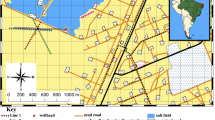Abstract
Based on the research of two geophone types (10 Hz moving-coil velocity and piezoelectric acceleration) and their velocity and acceleration parameters, frequency response functions have been determined, as well as the differences between them. Also, shock-vibration tests have been accomplished, not only to explain the two shock response signal differences, but also to analyze the response signal characteristics and its ability to carry information. In addition, seismic data acquisition experiments have been carried out under comparable conditions in the field. A contrast analysis of shot gathers and stack profiles acquired with the two geophone types is given in this paper. The results show that the acceleration signal from the acceleration geophone has a better advantage in terms of high signal-to-noise ratio, high accuracy, high resolution, and quantity of information to better meet current and future requirements for seismic exploration.
Similar content being viewed by others
References
Brincker, R., Bolton, B., and Brandt, A., 2011, Calibration and processing of geophone signals for structural vibration measurements: Structural Dynamics, 3, Conference Proceedings of the Society for Experimental Mechanics Series, 12, 1375–1379.
Chen, J. Y., Gong, J. T., Pang, J., and Xi, H., 2007, Research on technology and development of geophones: Computing Techniques for Geophysical and Geochemical Exploration (in Chinese), 29(5), 382–385.
Dong, S. X., and Zhang, C. Y., 2000, Seismic geophone property and precise seismic exploration: Geophysical Prospecting for Petroleum (in Chinese), 39(2), 124–130.
Hons, M. Stewart, R., Hauer, G., Lawton, D., and Bertram, M. B., 2008, Accelerometer versus geophone response-A field case history: 70th Conference & Technical Exhibition, EAGE, Extended Abstracts, B003.
Lansley, M., Laurin, M., and Ronen, S., 2007, Land 3D: Groups or single sensors? Cables or radio? Geophysical and operational considerations: 77th Ann. Internat. Mtg., Soc. Explor. Geophys., Expanded Abstracts, 6–10.
Lansley, M., Laurin, M., and Ronen, S., 2008, Modern land recording systems: How do they weigh up?: The Leading Edge, 27(7), 888–894.
Li, G. L., Chen, G., and Zhong, J. Y., 2009, Analysis of geophone properties effects for land seismic data: Applied Geophysics, 6(1), 93–101.
Li, Q. Z., 1994, The way to obtain a better resolution in seismic prospecting: Petroleum Industry Press, Beijing.
Lu, W. X., and Du, R. S., 2006, Measurement information signal analysis in mechanical engineering: Huazhong University of Science and Technology Press, Wuhan, 80–85.
Lv, G. H., 2005, Application of a new generation of geophone to improve seismic acquisition in onshore offshore transition areas: Applied Geophysics, 2(4), 235–240.
Lv, G. H., 2009, Analysis on principles and performance of seismic geophone and relevant issues: Geophysical Prospecting for Petroleum (in Chinese), 48(6), 531–543.
Mancini, F., Mougenot, J. M., and Suiter, J., 2008, Comparison of conventional geophones versus digital sensor - Preliminary results from 2D field test exercise: 70th Conference & Technical Exhibition, EAGE, Extended Abstracts, B015.
Pain, H. J., 2005, The physics of vibrations and waves (6th Edition), Wiley, New York.
Piersol, A. G., and Paez, T. L., 2009, Harris’ shock and vibration handbook (6th edition): McGraw-Hill, New York, USA.
Savazzi, S., and Spagnolini, U., 2008, Wireless geophone networks for high-density land technologies and acquisition: Future potential: The Leading Edge, 27(7), 882–886.
Shan, G. Y., Han, L. G., Zhang, L. H., and Dong, S. X., 2009, Experimental study on piezoelectric geophone in high resolution seismic exploration: Geophysical Prospecting for Petroleum (in Chinese), 48(1), 91–95.
Sheriff, R. E., and Geldart, L. P., 1995, Exploration seismology: Cambridge University Press, UK.
Stotter, C., and Angerer, E., 2011, Evaluation of 3C micro electromechanical system data on a 2D line: Direct comparison with conventional vertical-component geophone arrays and PS-wave analysis: Geophysics, 76(3), B79–B87.
Stotter, C., Angerer, E., and Herndler, E., 2008, Comparison of single sensor 3C MEMS and conventional geophone arrays for deep target exploration: 78th Ann. Internat. Mtg., Soc. Explor. Geophys., Expanded Abstracts, 173–177.
Tao, G., Zhang, X. L., Liu, X. R., Chen, S. H., and Liu, T. Y., 2009, A new type of fiber Bragg grating based seismic geophone: Applied Geophysics, 6(1), 84–92.
Wu, Z. Y., 1992, Measurement technology and measurement signal processing: Tsinghua University Press, Beijing.
Xiong, Z., 2009, High precision 3-D seismic-Part I Data acquisition: Progress in Exploration Geophysics (in Chinese), 32(1), 1–11.
Yuan, X. G., 1986, Sensors technical handbook: National Defense Industry Press, Beijing, 670–672.
Zheng, J. L., Ying, Q. X., and Yang, W. L., 2000, Signals and systems: Higher Education Press, Beijing.
Author information
Authors and Affiliations
Corresponding author
Additional information
The research is supported jointly by the National Natural Science Foundation Fund of China (No.40930418), Chinese government-funded scientific program of the SinoProbe Deep Exploration in China (SinoProbe03), and the National Science and Technology Support Program Project (No. 2011BAB04B01).
Liu Zhen-Dong, Senior engineer, graduated from China University of Petroleum in 1990 and received his PhD at China University of Geosciences. His research interests are in seismic exploration. Currently, he works at the post-doctoral research station of Chinese Academy of Geological Sciences.
Rights and permissions
About this article
Cite this article
Liu, ZD., Lu, QT., Dong, SX. et al. Research on velocity and acceleration geophones and their acquired information. Appl. Geophys. 9, 149–158 (2012). https://doi.org/10.1007/s11770-012-0324-6
Received:
Revised:
Published:
Issue Date:
DOI: https://doi.org/10.1007/s11770-012-0324-6




